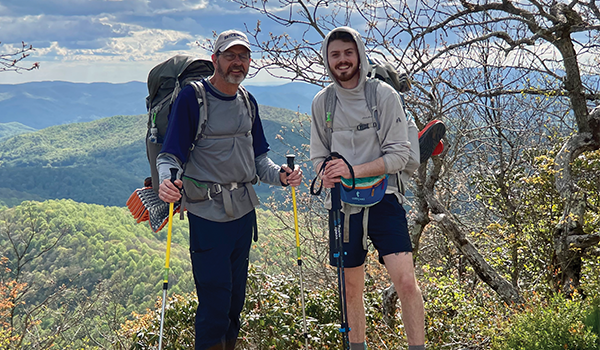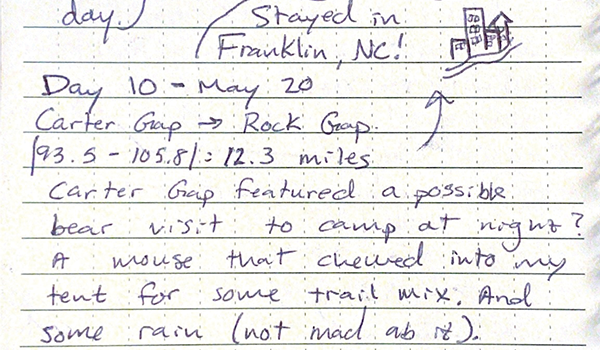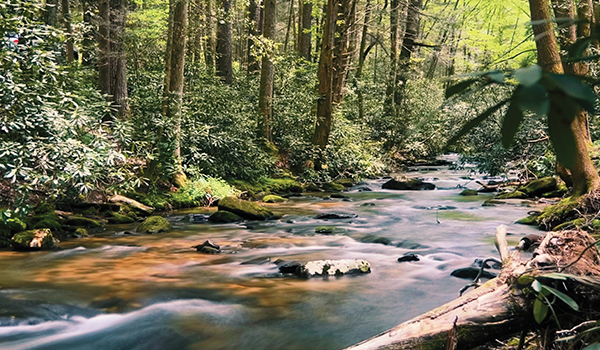The first hints of morning greeted Wesley Wohlford ’21 as he slung a 24-pound pack over his shoulders and began the day’s trek on the Appalachian Trail’s well-worn path. Like all other days, this one began around 6 a.m., a routine he described as “living with the sun.” With 2,190 miles of trail from Georgia to Maine to hike, early starts were essential.
Wohlford’s hike that morning took him through a section of North Georgia’s rugged mountains, a terrain marked with peaks of up to 4,461 feet and plunging to just 2,500 feet of elevation. Temperatures were often frigid in these mountains. For many hikers on the Appalachian Trail, it’s where their journeys really begin.
The Appalachian Trail is the longest hiking-only footpath in the world, offering a daunting challenge to hikers – like Wohlford – who attempt it. It takes the average person about 165 days to complete and, unsurprisingly, only a quarter of those who attempt the hike finish it.
Wohlford’s own journey on the trail began just two days after earning his environmental science degree from Gannon University in May 2021.
On May 9, he gathered a few essentials – a set of hiking clothes, a set of wool clothes, an extra pair of socks, a travel stove, spoon, headlamp, water filter, basic first aid, food and a tent – and headed north from the trail’s southern terminus at Springer Mountain, Ga.
“The first four or five days I only hiked about 10 miles a day. That’s what we call ‘acclimation.’ You’re just trying to get your legs used to the movement. It was very cold,” Wohlford said. “You’re just shivering for the first mile trying to get warm.”
Wohlford’s father, Greg Wohlford, hiked with him the first few days before returning to work.

Wesley Wohlford '21 hiking Blood Mountain, Ga. with his father, Greg Wohlford.
“I remember we had just exited this wilderness area and came to a state route where my dad was picked up. I’m just watching the car drive away and there’s no one else around,” Wohlford said. “The only thing I could do is climb back up in the mountains by myself. I pitched my tent alone that night for the first time. It was a real gut check.”
Determined, Wohlford stepped into a routine of hiking an average of 14 miles a day. Near evening he’d pitch his tent or – if available – settle into one of the trail’s three-walled shelters. Next would be to locate and filter water to be used for cooking, washing and drinking. He’d also hang his food in a tree away from bears and other animals.
Seventy-eight miles into the journey, Wolhford reached his first milestone: the Georgia state line. From there, he headed into North Carolina and into Tennessee’s Great Smoky Mountain National Park – a 71-mile section of the trail known particularly for its variable weather patterns, elevation changes, and remote stretches.
“When I got into the Smokies it was instantly back down to 40 degrees,” Wohlford said. “I didn’t really see the sun for seven days. I’d wake up and my hands were purple as I was packing. I shivered for about the first mile until I could finally warm up.”
As it is for many hikers, solitude was an inevitable part of the journey. For Wohlford, he said it was one of the biggest challenges.
“I knew I needed to build friendships to last me however long I was going to be out there,” Wohlford said. His mid-May start had put him behind, and the trail was relatively vacant. But Wohlford found a few hiking companions.
“We call it a ‘tramily,’ like a ‘trail family.’ We would hike together pretty consistently and then camp together at night,” Wohlford said.

Wesley Wohlford’s ’21 journal that he kept during his hike.
Bolstered by the camaraderie, Wohlford pushed across the Smokies, ascending the highest point along the entire trail: Clingman’s Dome at more than 6,600 feet. A one-day 20-miler pushed him into Virginia, a state that holds a daunting 530 miles of trail.
Wohlford described it as a “grind against the Virginia wilderness.”
“In Southern Virginia it’s super rocky,” Wohlford said. Even still, he said he enjoyed the state’s rocky overlooks that transitioned to rolling hills and pastoral scenes. “It was very welcome,” he said.
Wohlford said what kept him moving was the vision of reaching the north. “The landscape shifts into this kind of mystical place,” he said. “That’s what drew me forward. There are huge mountains. You’re above the trees. It’s very climactic.”
He stopped – for now – in Virginia’s Shenandoah National Park. He had walked 764 miles in 67 days.
Wolhford said he plans to return to the Appalachian Trail in the spring. If he can walk the remaining 1,426 miles early enough in the season, he could achieve honorable status as a “thru-hiker.”

A forested stream in Georgia, which Wesley Wohlford ’21 said runs along one of his favorite sections of the trail.
Wohlford said he felt conflicted about leaving the trail, but the experience gave him a new career outlook. Until he returns to the trail, Wohlford will work with the American Conservation Experience to assist in building and maintaining trails and conducting habitat restoration projects in Utah’s “Mighty Five” national parks.
“Hiking the AT gave me a new perspective on land conservation. It really is an incredible privilege to have these protected lands in America,” Wolhford said. “The AT is just a dirt path mainly, but it can open up a whole new world for people. They need these experiences, and we need to protect that.”
By Brianna Mariotti, marketing and content strategist